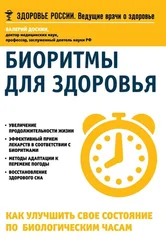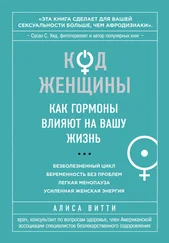12. K. J. Reid et al., «Aerobic Exercise Improves Self-Reported Sleep and Quality of Life in Older Adults with Insomnia», Sleep Medicine 11, no. 9 (2010): 934 – 40.
13. S. S. Tworoger et al., «Effects of a Yearlong Moderate-Intensity Exercise and a Stretching Intervention on Sleep Quality in Postmenopausal Women», Sleep 26, no. 7 (2003): 830—36.
14. E. J. van Someren et al., «Long-Term Fitness Training Improves the Circadian Rest-Activity Rhythm in Healthy Elderly Males», Journal of Biological Rhythms 12, no. 2 (1997): 146—56.
ГЛАВА 3. Проверьте и оцените: насколько оптимален ваш циркадный код?
1. F. C. Bell and M. L. Miller, «Life Tables for the United States Social Security Area 1900–2100», Social Security Administration, https://www.ssa.gov/oact/NOTES/as120/LifeTables_Body.html.
2. C. R. Marinac et al., «Prolonged Nightly Fasting and Breast Cancer Prognosis», JAMA Oncology 2, no. 8 (2016): 1049—55.
3. A. J. Davidson et al., «Chronic Jet-Lag Increases Mortality in Aged Mice», Current Biology 16, no. 21 (2006): R914—16.
4. D. C. Mohren et al., «Prevalence of Common Infections Among Employees in Difef rent Work Schedules», Journal of Occupational and Environmental Medicine 44, no. 11 (2002): 1003—11.
5. N. J. Schork, «Personalized Medicine: Time for One-Person Trials», Nature 520, no. 7549 (2015): 609—11.
6. B. J. Hahm et al., «Bedtime Misalignment and Progression of Breast Cancer», Chronobiology International 31, no. 2 (2014): 214—21.
7. E. L. McGlinchey et al., «The Effect of Sleep Deprivation on Vocal Expression of Emotion in Adolescents and Adults», Sleep 34, no. 9 (2011): 1233— 41.
8. S. J. Wilson et al., «Shortened Sleep Fuels Inflammatory Responses to Marital Conflict: Emotion Regulation Matters», Psychoneuroendocrinology 79 (2017): 74–83. 9. S. Gill and S. Panda, «A Smartphone App Reveals Erratic Diurnal Eating Patterns in Humans That Can Be Modulated for Health Benefits», Cell Metabolism 22, no. 5 (2015): 789—98.
10. Ibid.
11. N. J. Gupta, V. Kumar, and S. Panda, «A Camera-Phone Based Study Reveals Erratic Eating Pattern and Disrupted Daily Eating-Fasting Cycle among Adults in India», PLoS ONE 12, no. 3 (2017): e0172852.
12. M. Ohayon et al., «National Sleep Foundation’s Sleep Quality Recommendations: First Report», Sleep Health 3, no. 1 (2017): 6—19.
13. M. Hirshkowitz et al., «National Sleep Foundation’s Sleep Time Duration Recommendations: Methodology and Results Summary», Sleep Health 1, no. 1 (2015): 40–43.
14. M. Hirshkowitz et al., «National Sleep Foundation’s Updated Sleep Duration Recommendations: Final Report», Sleep Health 1, no. 4 (2015): 233—43.
ГЛАВА 4. Циркадный код для улучшения ночного сна
1. M. Hirshkowitz et al., «National Sleep Foundation’s Sleep Time Duration Recommendations: Methodology and Results Summary», Sleep Health 1, no. 1 (2015): 40–43.
2. M. Hirshkowitz et al., «National Sleep Foundation’s Updated Sleep Duration Recommendations: Final Report», Sleep Health 1, no. 4 (2015): 233— 43.
3. D. F. Kripke et al., «Mortality Associated with Sleep Duration and Insomnia», Archives of General Psychiatry 59, no. 2 (2002): 131—36.
4. G. Yetish et al., «Natural Sleep and Its Seasonal Variations in Three Pre-Industrial Societies», Current Biology 25, no. 21 (2015): 2862—68.
5. H. O. de la Iglesia et al., «Access to Electric Light Is Associated with Shorter Sleep Duration in a Traditionally Hunter-Gatherer Community», Journal of Biological Rhythms 30, no. 4 (2015): 342—50. 6. A. M. Williamson and A. M. Feyer, «Moderate Sleep Deprivation Produces Impairments in Cognitive and Motor Performance Equivalent to Legally Prescribed Levels of Alcohol Intoxication», Occupational & Environmental Medicine 57, no. 10 (2000): 649—55. 7. H. P. van Dongen et al., «The Cumulative Cost of Additional Wakefulness: Dose-Response Effects on Neurobehavioral Functions and Sleep Physiology from Chronic Sleep Restriction and Total Sleep Deprivation», Sleep 26, no. 2 (2003): 117—26. 8. R. E. Fargason et al., «Correcting Delayed Circadian Phase with Bright Light Therapy Predicts Improvement in ADHD Symptoms: A Pilot Study», Journal of Psychiatric Research 91 (2017): 105—10. 9. N. Kronfeld-Schor and H. Einat, «Circadian Rhythms and Depression: Human Psychopathology and Animal Models», Neuropharmacology 62, no. 1 (2012): 101—14.
10. M. E. Coles, J. R. Schubert, and J. A. Nota, «Sleep, Circadian Rhythms, and Anxious Traits», Current Psychiatry Reports 17, no. 9 (2015): 73.
11. S. E. Anderson et al., «Self-Regulation and Household Routines at Age Three and Obesity at Age Eleven: Longitudinal Analysis of the UK Millennium Cohort Study», International Journal of Obesity 41, no. 10 (2017): 1459—66.
12. A. W. McHill et al., «Impact of Circadian Misalignment on Energy Metabolism during Simulated Nightshift Work», Proceedings of the National Academy of Sciences of the United States of America 111, no. 48 (2014): 17302—7.
13. B. Martin, M. P. Mattson, and S. Maudsley, «Caloric Restriction and Intermittent Fasting: Two Potential Diets for Successful Brain Aging», Ageing Research Reviews 5, no. 3 (2006): 332—53.
14. S. Gill and S. Panda, «A Smartphone App Reveals Erratic Diurnal Eating Patterns in Humans That Can Be Modulated for Health Benefits», Cell Metabolism 22, no. 5 (2015): 789—98.
15. S. J. Crowley and C. I. Eastman, «Human Adolescent Phase Response Curves to Bright White Light», Journal of Biological Rhythms 32, no. 4 (2017): 334— 44.
16. J. A. Evans et al., «Dim Nighttime Illumination Alters Photoperiodic Responses of Hamsters through the Intergeniculate Leaflet and Other Photic Pathways», Neuroscience 202 (2012): 300–308.
17. L. S. Gaspar et al., «Obstructive Sleep Apnea and Hallmarks of Aging», Trends in Molecular Medicine 23, no. 8 (2017): 675—92.
18. E. Ferracioli-Oda, A. Qawasmi, and M. H. Bloch, «Meta-Analysis: Melatonin for the Treatment of Primary Sleep Disorders», PLoS ONE 8, no. 5 (2013): e63773.
ГЛАВА 5. Ограничение времени питания: настройте свои часы на снижение веса
1. C. M. McCay and M. F. Crowell, «Prolonging the Life Span», Scientific Monthly 39, no. 5 (1934): 405—14.
2. S. K. Das, P. Balasubramanian, and Y. K. Weerasekara, «Nutrition Modulation of Human Aging: The Calorie Restriction Paradigm», Molecular and Cellular Endocrinology 455 (2017): 148—57.
3. A. Kohsaka et al., «High-Fat Diet Disrupts Behavioral and Molecular Circadian Rhythms in Mice», Cell Metabolism 6, no. 5 (2007): 414—21.
4. M. Hatori et al., «Time-Restricted Feeding without Reducing Caloric Intake Prevents Metabolic Diseases in Mice Fed a High-Fat Diet», Cell Metabolism 15, no. 6 (2012): 848—60.
5. A. Chaix et al., «Time-Restricted Feeding Is a Preventative and Therapeutic Intervention against Diverse Nutritional Challenges», Cell Metabolism 20, no. 6 (2014): 991—1005.
6. A. Zarrinpar et al., «Diet and Feeding Pattern Affect the Diurnal Dynamics of the Gut Microbiome», Cell Metabolism 20, no. 6 (2014): 1006—17.
7. V. A. Acosta-Rodriguez et al., «Mice under Caloric Restriction Self-Impose a Temporal Restriction of Food Intake as Revealed by an Automated Feeder System», Cell Metabolism 26, no. 1 (2017): 267—77.e2. 8. M. Garaulet et al., «Timing of Food Intake Predicts Weight Loss Effectiveness», International Journal of Obesity 37, no. 4 (2013): 604—11. 9. S. Gill and S. Panda, «A Smartphone App Reveals Erratic Diurnal Eating Patterns in Humans That Can Be Modulated for Health Benefits», Cell Metabolism 22, no. 5 (2015): 789—98.
Читать дальше
Конец ознакомительного отрывка
Купить книгу










